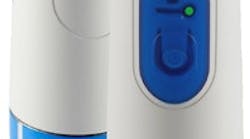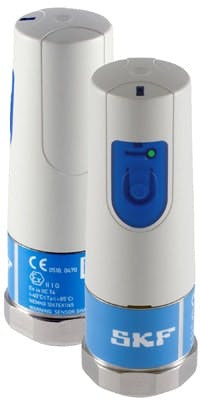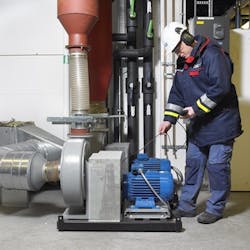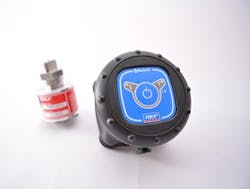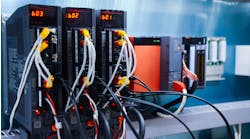Proactive maintenance depends upon gathering intelligence on operating machinery to detect faults in advance of failures. Collecting and analyzing data on parameters such as vibration and temperature that indicate the health of equipment ultimately can serve to promote machine reliability and availability, extend intervals for scheduled maintenance, and help decrease unplanned downtime and lost output due to compromised assets.
Figure 1. This compact battery-powered device measures vibration and temperature, and contains a sensor, data collector and radio.
Over the years, advances in the design, function, performance and benefit/cost ratio of interrelated data collection, software analytics, monitoring and analysis technologies have bolstered our ability to capture, diagnose and trend information on the operating condition of machinery — and thus prevent failures and make timely fixes.
Serving as a pre-emptive line of defense for condition monitoring, sensors and compatible data-acquisition and monitoring tools illustrate how far the technology has come. The toolbox of industrial sensors — whether hard-wired or wireless online systems — now includes an increasing number of options. Monitoring systems and analysis techniques have benefited from similar strides.
[javascriptSnippet ]
Any process plant evaluating the potential role of sensor technologies should carefully assess how deeply to dive into implementation and what approach will work best within the existing culture and capabilities of its organization. So, this article provides an overview of the vibration sensor landscape to help guide and inform the decision-making.
Vibration Sensors
Measuring vibration is the most common method to monitor the mechanical condition of plant machinery. Vibration sensors convert mechanical motion into an electrical signal. Key parameters for assessment include displacement (or distance), velocity (rate of change of displacement) and acceleration (rate of change of velocity).
Displacement sensors (or eddy current probes) measure the relative distance between two surfaces and will deliver accurate low-frequency responses. However, they provide only limited sensitivity to high frequencies and require external power sources. Velocity sensors measure vibration in bearing housings or the casing of machinery and are designed to be effective in low- to mid-frequency ranges (10– 1,000 Hz). Accelerometers measure rate of velocity change; some models can handle rugged and demanding conditions, making them especially attractive for many chemical processing operations.
Vibration sensors can uncover a variety of problems that might afflict machine housings and rotors. Housing-related targets can include looseness or deterioration of supports, bearing failure, piping issues, structural resonance, loose non-rotating parts, loose fits, thermal warping and improper housing assemblies. Rotor-related targets can include unbalance, misalignment, bearing wear or failure, coupling issues, gear wear, oil whirl/whip instabilities, lubricant loss, loose rotating parts, cracked shaft and improper rotor assemblies.
Figure 2. Unit collects data from multiple fixed sensors and transmits those data wirelessly to a host computer or distributed control system.
In general for chemical processing operations, key sensor requirements will include: a minimum 10–10,000-Hz frequency response to effectively monitor turbines, blades and gears; sensitivity precision to perform reliably in noisy environments; and high EMI/RFI shielding capabilities to prevent signal distortion. In addition, for use in areas where hazardous explosive gases or vapor may exist, the sensor should have ATEX or NEC certification.
Wired Versus Wireless
After selecting the sensor technology for your online system, you next must choose whether to employ a wired setup or “cut the cord” completely by going wireless.
Hard-wired sensors come in numerous variations to accommodate particular industry-specific requirements or conditions. They connect to data-acquisition devices that relay data via a wired or wireless network to a plant’s server and analysis workstation. Selection depends upon the type and design of the equipment to be monitored, frequencies of interest, rate of failure and signal levels involved — all in the context of prevailing operating conditions.
As one example, rugged, economical accelerometers now available can serve as all-around general-purpose devices. They exhibit 100-mV/g sensitivity for optimized use in multiple applications, exceptional bias voltage stability in elevated temperatures, low noise level over a wide temperature range and corrosion resistance. Devices also feature reverse-polarity wiring protection and hermetically sealed construction to cope with high humidity areas.
Wired sensors typically are mounted in the load zone of a bearing, either radially or axially with adhesives or threaded studs, depending largely on the application. The dynamic measurement requirements, such as frequency and amplitude range, primarily determine the mounting configuration of sensors. The locations for mounting must be readily accessible; the cabling for connections must allow for other maintenance activities around a machine without interfering with sensors or cables. In the end, how the mounting and wiring are performed impacts a sensor’s performance and reliability; always follow proper procedures.
Wireless online sensor systems have emerged as highly versatile alternatives to wired sensor technology. Their untethered operation removes cabling obstacles from the plant floor (promoting worker safety), obviates wiring (which often can be complex and costly), and enables monitoring of machine parameters even in the most difficult-to-access or dangerous locations.
The recent development of a compact, battery-operated device (Figure 1) to measure vibration and temperature data exemplifies how far the technology has advanced. System components consist of the wireless machine-condition sensors, WirelessHART communications protocol gateway, wireless sensor device manager software and analysis software. The technology wirelessly transmits data to monitoring suite software and plant control systems; it is suitable for use in extremely hazardous and explosive areas requiring ATEX Zone 0 certification.
Such a device can augment readings taken by workers during walk-arounds by collecting data automatically and more frequently from plant areas where manual data retrieval might be uneconomic, impractical or unsafe. Temporary installation of the sensor on suspect equipment can enhance troubleshooting by enabling much closer tracking of failing components; the device also allows acquisition of vibration data in locations difficult to monitor with wired systems or handheld devices.
Another example of an advance in technology is the introduction of multi-channel, field-mounted, wireless online monitoring devices. They collect data from fixed sensors and use a wireless network for relaying to a host computer or distributed control system (Figure 2). Such devices automatically upload data for viewing, alarm evaluation and analysis, and send timely notifications of impending issues needing remedial actions. They can handle a substantial range of data: an 8-channel device can relay data on acceleration, velocity, displacement, temperature and bearing condition, among other parameters. Resulting benefits include 24/7 monitoring, the capability to expand monitoring coverage, easy relocation when necessary and fully untethered operation. Moreover, multiple users — even those at remote locations — can review the information gathered.
Multi-channel instrumentation with even greater reach and capabilities also has been developed — and further progress surely will occur in the years ahead.
Implementation Issues
Many plants wonder which assets they should “sensorize.” A variety of factors influences the choice — there’s no “one size fits all.” Typical considerations include safety and environment issues relating to a machine’s location, frequency of failure and history of repair expenses, as well as the availability of funding for sensor implementation and operation.
Figure 3. During a walk-around, a worker takes readings from a permanently installed wired sensor.
The most critical machinery usually should have fixed wired sensors, with data collected regularly — either automatically through a network or manually by workers during walk-arounds (Figure 3). However, portable or temporary sensors also can play an important role. These devices can provide insights for troubleshooting operating machinery, keep a watchful eye on equipment that may be showing early signs of impending problems or confirm the health of an asset prior to the end of a warranty period. In addition, sensors installed for only a 24-hr period can verify that just-completed maintenance work was performed correctly and the asset is running as intended.
Achieving optimal results from sensors begins with proper selection and installation to ensure reliable signal information. Poor quality sensors or improper installation easily can result in misleading data and a critical machine condition being completely overlooked.
Commonly used sensors usually require minimal, if any, maintenance. However, adhering to some general guidelines will contribute to the effectiveness of a vibration-monitoring program and the overriding goal of promoting increased machinery uptime. These include:
• Once a sensor has been installed, institute procedures to monitor the performance of all measurement channels to confirm the integrity of the vibration information base.
• Verify sensor calibration or validate sensitivity once a year for those applications requiring high-accuracy amplitude measurements. (A qualified technician can perform calibration on-site.)
• Regularly check bias output voltage (the base DC voltage upon which the AC vibration signal is carried); this is a key indicator of accelerometer health. Such a reading or a continuous trend in an online system will reveal deterioration in the electronics inside the sensor. Also, look for potential damage to sensor cabling. The majority of today’s data acquisition systems automatically monitor sensor bias voltage and provide notification of potential sensor issues.
• Take advantage of existing or planned wireless networks to add vibration sensors, thereby capitalizing even more on that investment.
Figure 4. Combining a powerful mobile app with a special Bluetooth-enabled vibration sensor allows non-expert staff to gather data via smartphones or tablets.
A Common Challenge
Many plants find that analyzing the data provided by the sensors is the most daunting aspect of a condition-monitoring program. Without proper analysis, the effort won’t reach full potential. Professional expertise, of course, is available to assist in setups, interpret data, and realize system benefits. Other avenues exist, too, especially with the advent of user-friendly and highly simplified technologies to help sites at least get started on the right foot.
Case in point: a new platform combines a powerful mobile app with a special Bluetooth-enabled vibration sensor to allow non-expert staff to gather critical machinery data (Figure 4); it effectively turns a standard mobile device such as a smartphone or tablet into a data-collection unit. In the event of a parameter warning or alert, the user can request an on-demand diagnostic, whereby the data are sent wirelessly with the single push of a button to a remote diagnostic center for expert analysis and reporting.
Unlike route-based systems or dedicated high-end vibration analyzers that require skilled staff and are especially costly for one-off data measurements, the new platform provides low-cost, fast and easy-to-use instrumentation with instant connection to expertise. Specially built and intrinsically safe ATEX Zone 1-compliant smartphones and tablets enable data collection in hazardous areas.
The platform consists of Data Collect (the app) and the Wireless Machine Condition Detector (WMCD), a sensor that mounts magnetically to a machine and measures vibration data. Data relayed to the app via Bluetooth are benchmarked against ISO standards for vibration levels. The user sees the assessment as a simple traffic-light indicator (red, amber or green). If an on-demand diagnostic is warranted, an expert then would analyze the data and e-mail the user a report on the cause of any fault along with recommended remedial actions.
The WMCD sensor additionally takes a simultaneous measurement of bearing condition using patented algorithms to assess the severity of any damage or wear. These results also appear in traffic-light format and can be sent for on-demand analysis and recommendations.
With today’s growing pressure to optimize operations, plants should rely on sensor technology, from basic to highly sophisticated, to help bolster maintenance practices and timely scheduling, promote better machine reliability, and achieve improved productivity and profitability.
GREG ZIEGLER is business development manager, online systems, for SKF USA, Inc., Lansdale, Pa. E-mail him at [email protected].
